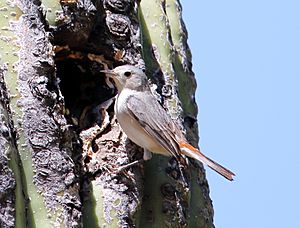Lucy's warbler facts for kids
Quick facts for kids Lucy's warbler |
|
|---|---|
 |
|
| Conservation status | |
| Scientific classification | |
| Genus: |
Leiothlypis
|
| Species: |
luciae
|
 |
|
| Range of L. luciae Breeding range Year-round range Winter range | |
| Synonyms | |
|
Vermivora luciae |
|
Lucy's warbler (scientific name: Leiothlypis luciae) is a tiny songbird. It's a type of New World warbler, which means it's a small bird found only in the Americas. You can find Lucy's warblers in the southwestern United States and northwestern Mexico. What makes them special is that they are one of only two warblers that build their nests inside holes or cavities.
Contents
What Does Lucy's Warbler Look Like?
Lucy's warbler is the smallest type of New World warbler. It is about 9 to 12 cm (3.5 to 4.7 in) long, which is roughly the size of your finger. These birds are very light, weighing only 5.1 to 7.9 g (0.18 to 0.28 oz). That's less than a quarter!
Compared to other warblers, Lucy's warbler looks quite plain. Its head and back are a light gray color. Its belly is whitish. It has a white ring around its eye and a small, pointed bill.
Both male and female Lucy's warblers have a reddish-brown patch on their rump (the area above their tail). This is a great way to identify them! Adult males also have a small rusty patch on the top of their head. Young birds are even paler, with a light brown rump.
Lucy's warbler is related to birds like Virginia's warbler and Nashville warbler. This bird was named after Lucy Hunter Baird. She was the daughter of a famous bird expert named Spencer Fullerton Baird.
Where Do Lucy's Warblers Live?
Lucy's warblers live near rivers in areas with mesquite trees and thick bushes. These places are found in the southwestern United States and northwestern Mexico. They can even nest in the driest parts of the Sonoran Desert. This makes them unique among New World warblers, as they can live in very dry places.
Life and Habits of Lucy's Warbler
Lucy's warblers are special because they are one of only two warblers that nest in holes. The other is the prothonotary warbler. They use natural holes in cactus plants or trees. They also use holes made by woodpeckers or other birds like the verdin in earlier years.
Unlike the prothonotary warbler, Lucy's warblers will sometimes use man-made nest boxes. They have even used a hollowed-out gourd! If they use a woodpecker hole, they might fill it almost to the top with twigs and leaves. Then they build their nest on top. This helps the small birds see outside the hole.
These birds often nest close to each other. You might find as many as 12 pairs of warblers in a small area. When winter comes, Lucy's warblers migrate (travel) south to western Mexico.
What Do Lucy's Warblers Eat?
Lucy's warblers are insectivores, meaning they eat only insects. They actively search for food, looking for caterpillars, beetles, and leafhoppers. These insects make up most of their diet. When they catch a caterpillar, they shake it hard. They also rub off the prickly hairs on its back before eating it.
Threats to Lucy's Warbler
The biggest danger to Lucy's warblers is the loss of their habitat. The areas near rivers where they live are often developed by people. This means less space for the birds to live and nest.
Another problem is a bird called the brown-headed cowbird. Cowbirds are known for laying their eggs in the nests of other birds. The cowbird chicks then often outcompete the warbler chicks for food. Because of these threats, the number of Lucy's warblers is decreasing in many areas where they live.
See also
 In Spanish: Reinita de Lucy para niños
In Spanish: Reinita de Lucy para niños


